CHRYSLER TOWN AND COUNTRY 2015 5.G Owners Manual
Manufacturer: CHRYSLER, Model Year: 2015, Model line: TOWN AND COUNTRY, Model: CHRYSLER TOWN AND COUNTRY 2015 5.GPages: 726, PDF Size: 20.14 MB
Page 471 of 726
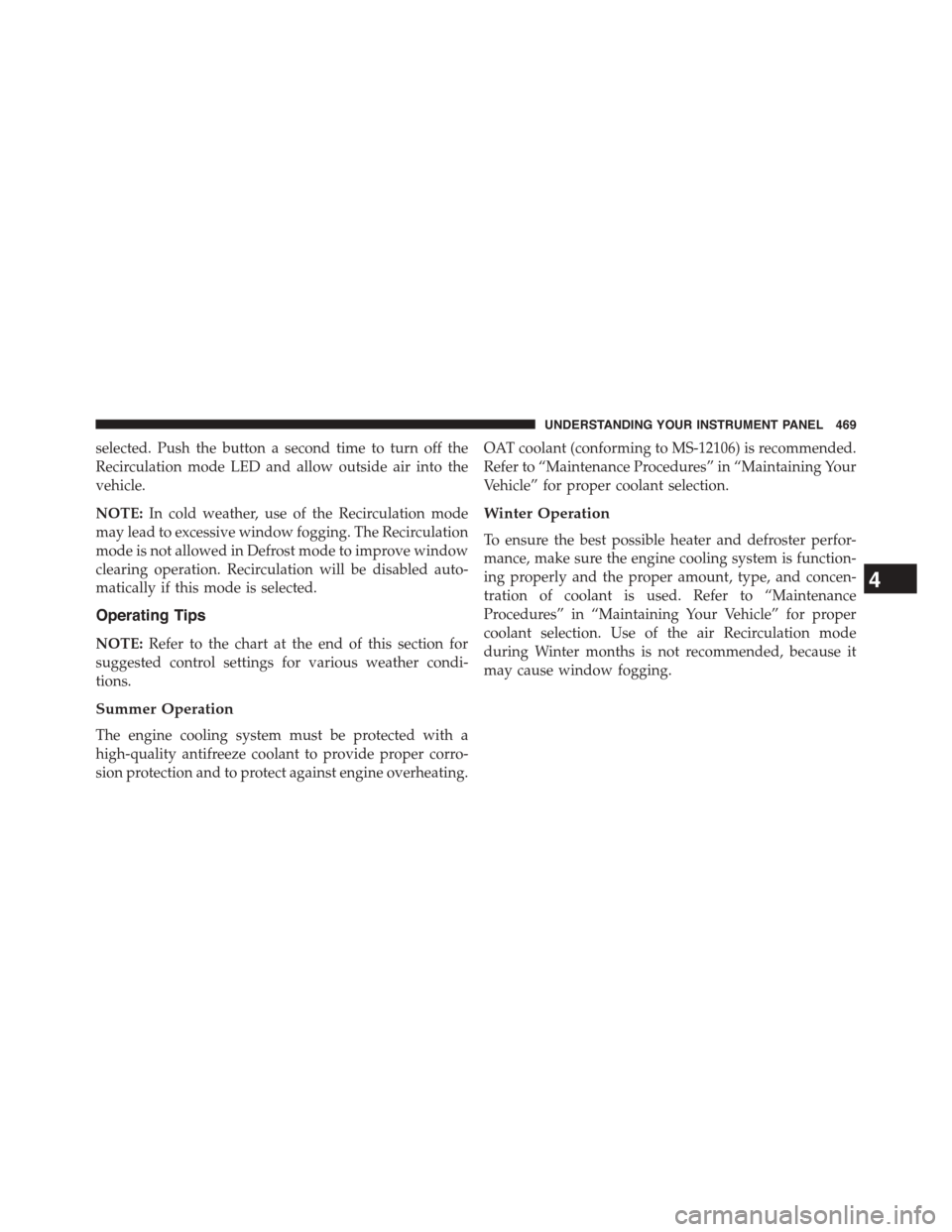
selected. Push the button a second time to turn off the
Recirculation mode LED and allow outside air into the
vehicle.
NOTE:In cold weather, use of the Recirculation mode
may lead to excessive window fogging. The Recirculation
mode is not allowed in Defrost mode to improve window
clearing operation. Recirculation will be disabled auto-
matically if this mode is selected.
Operating Tips
NOTE:Refer to the chart at the end of this section for
suggested control settings for various weather condi-
tions.
Summer Operation
The engine cooling system must be protected with a
high-quality antifreeze coolant to provide proper corro-
sion protection and to protect against engine overheating.
OAT coolant (conforming to MS-12106) is recommended.
Refer to “Maintenance Procedures” in “Maintaining Your
Vehicle” for proper coolant selection.
Winter Operation
To ensure the best possible heater and defroster perfor-
mance, make sure the engine cooling system is function-
ing properly and the proper amount, type, and concen-
tration of coolant is used. Refer to “Maintenance
Procedures” in “Maintaining Your Vehicle” for proper
coolant selection. Use of the air Recirculation mode
during Winter months is not recommended, because it
may cause window fogging.
4
UNDERSTANDING YOUR INSTRUMENT PANEL 469
Page 472 of 726
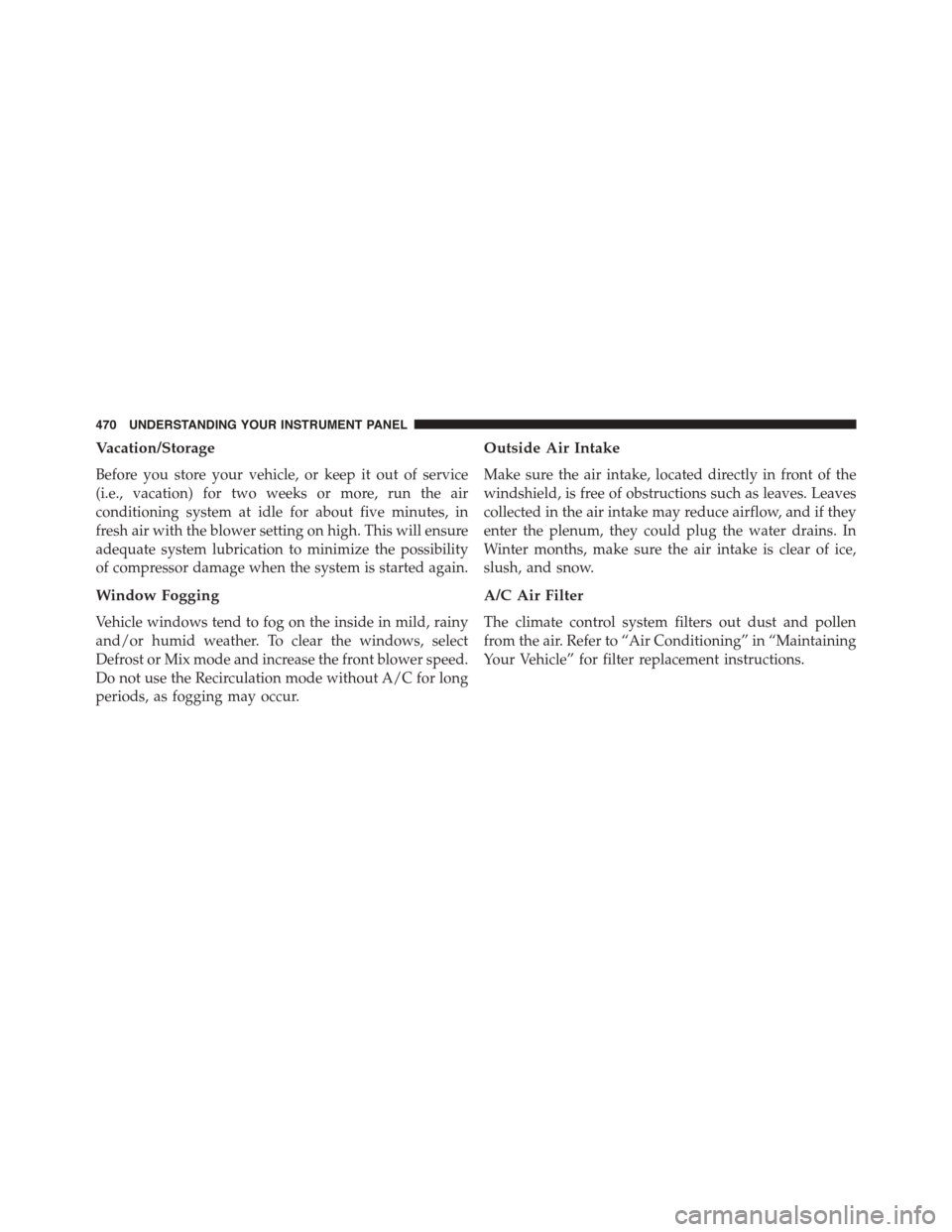
Vacation/Storage
Before you store your vehicle, or keep it out of service
(i.e., vacation) for two weeks or more, run the air
conditioning system at idle for about five minutes, in
fresh air with the blower setting on high. This will ensure
adequate system lubrication to minimize the possibility
of compressor damage when the system is started again.
Window Fogging
Vehicle windows tend to fog on the inside in mild, rainy
and/or humid weather. To clear the windows, select
Defrost or Mix mode and increase the front blower speed.
Do not use the Recirculation mode without A/C for long
periods, as fogging may occur.
Outside Air Intake
Make sure the air intake, located directly in front of the
windshield, is free of obstructions such as leaves. Leaves
collected in the air intake may reduce airflow, and if they
enter the plenum, they could plug the water drains. In
Winter months, make sure the air intake is clear of ice,
slush, and snow.
A/C Air Filter
The climate control system filters out dust and pollen
from the air. Refer to “Air Conditioning” in “Maintaining
Your Vehicle” for filter replacement instructions.
470 UNDERSTANDING YOUR INSTRUMENT PANEL
Page 473 of 726
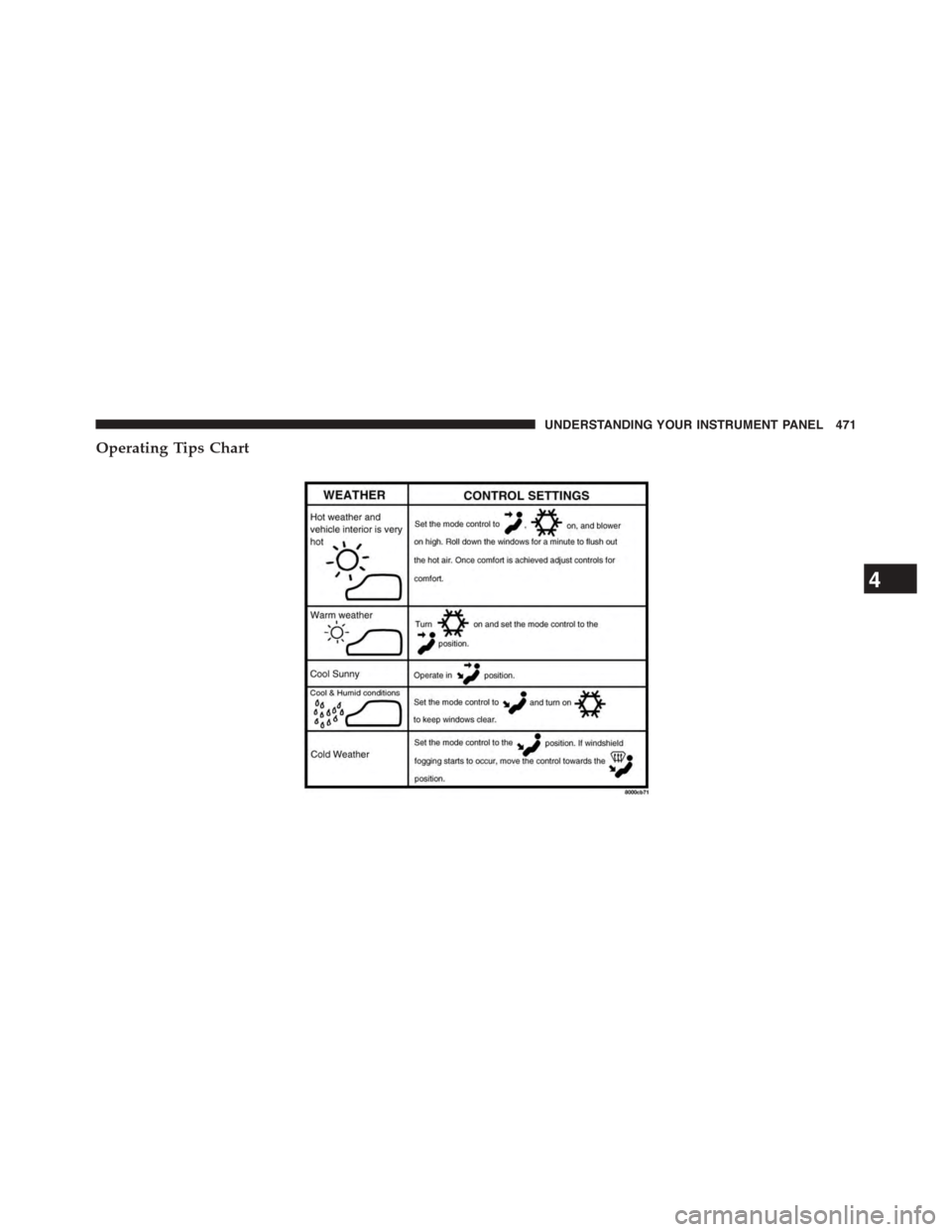
Operating Tips Chart
4
UNDERSTANDING YOUR INSTRUMENT PANEL 471
Page 474 of 726

Page 475 of 726
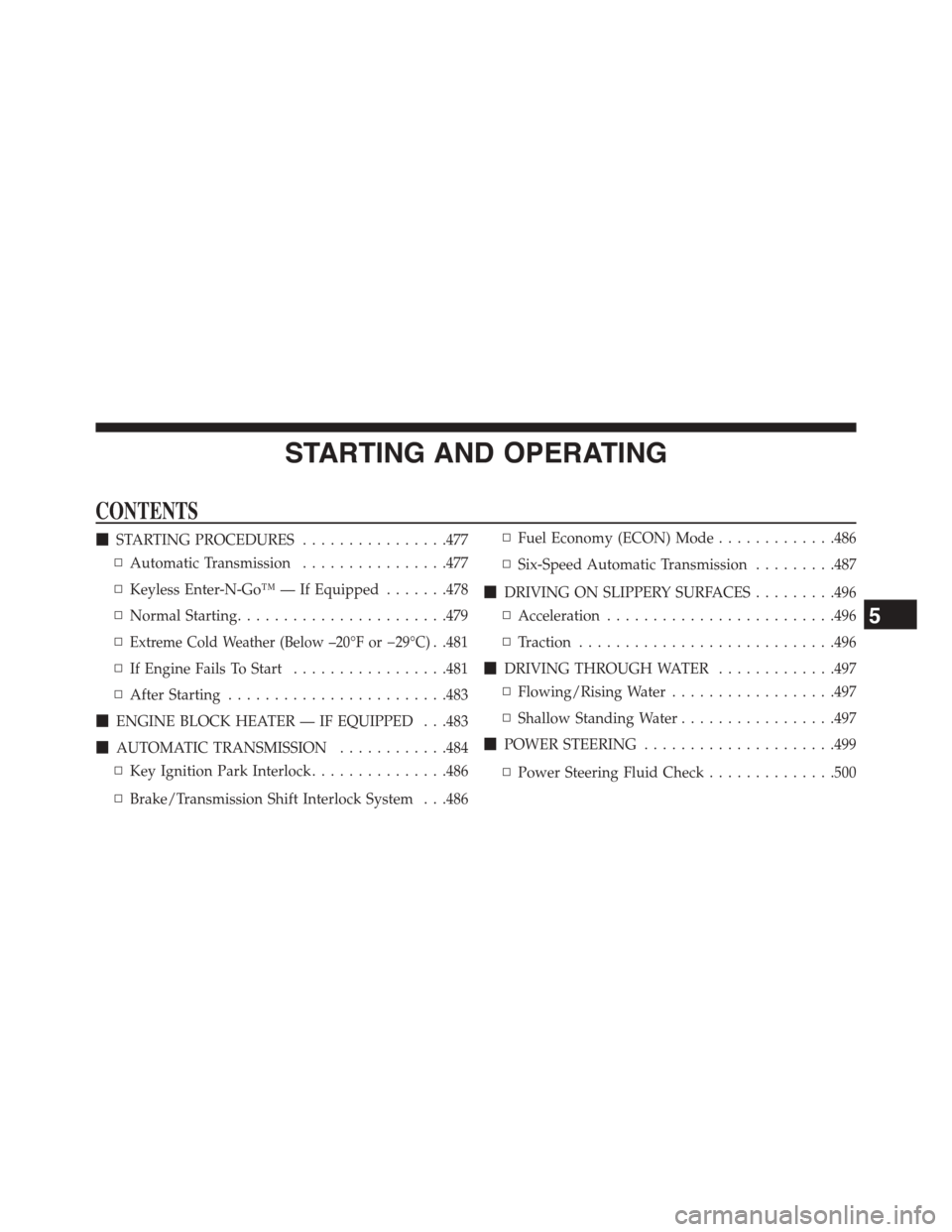
STARTING AND OPERATING
CONTENTS
!STARTING PROCEDURES................477
▫Automatic Transmission................477
▫Keyless Enter-N-Go™ — If Equipped.......478
▫Normal Starting.......................479
▫Extreme Cold Weather (Below –20°F or−29°C). .481
▫If Engine Fails To Start.................481
▫After Starting........................483
!ENGINE BLOCK HEATER — IF EQUIPPED . . .483
!AUTOMATIC TRANSMISSION............484
▫Key Ignition Park Interlock...............486
▫Brake/Transmission Shift Interlock System . . .486
▫Fuel Economy (ECON) Mode.............486
▫Six-Speed Automatic Transmission.........487
!DRIVING ON SLIPPERY SURFACES.........496
▫Acceleration.........................496
▫Traction............................496
!DRIVING THROUGH WATER.............497
▫Flowing/Rising Water..................497
▫Shallow Standing Water.................497
!POWER STEERING.....................499
▫Power Steering Fluid Check..............500
5
Page 476 of 726
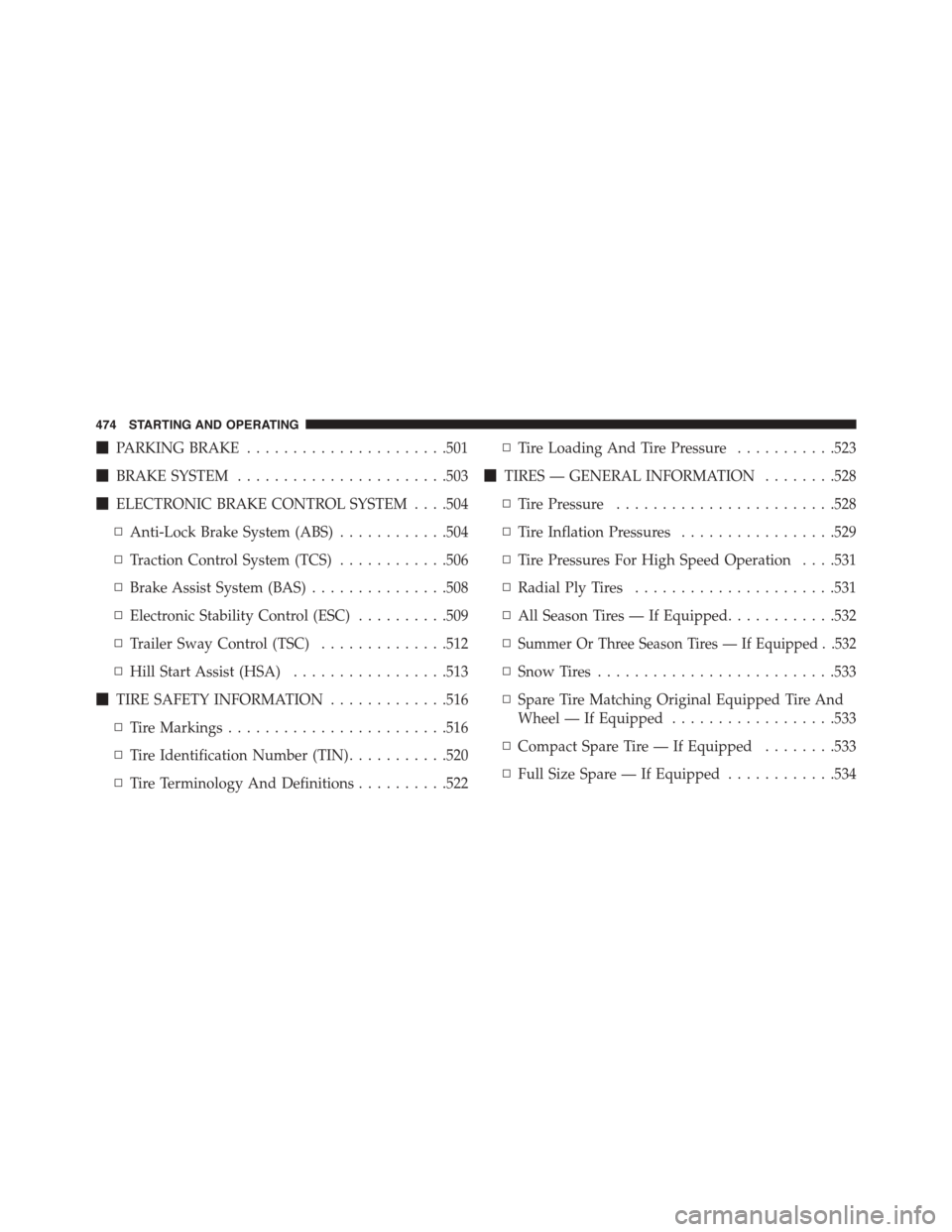
!PARKING BRAKE......................501
!BRAKE SYSTEM.......................503
!ELECTRONIC BRAKE CONTROL SYSTEM . . . .504
▫Anti-Lock Brake System (ABS)............504
▫Traction Control System (TCS)............506
▫Brake Assist System (BAS)...............508
▫Electronic Stability Control (ESC)..........509
▫Trailer Sway Control (TSC)..............512
▫Hill Start Assist (HSA).................513
!TIRE SAFETY INFORMATION.............516
▫Tire Markings........................516
▫Tire Identification Number (TIN)...........520
▫Tire Terminology And Definitions..........522
▫Tire Loading And Tire Pressure...........523
!TIRES — GENERAL INFORMATION........528
▫Tire Pressure........................528
▫Tire Inflation Pressures.................529
▫Tire Pressures For High Speed Operation . . . .531
▫Radial Ply Tires......................531
▫All Season Tires — If Equipped............532
▫Summer Or Three Season Tires — If Equipped . .532
▫Snow Tires..........................533
▫Spare Tire Matching Original Equipped Tire And
Wheel — If Equipped..................533
▫Compact Spare Tire — If Equipped........533
▫Full Size Spare — If Equipped............534
474 STARTING AND OPERATING
Page 477 of 726
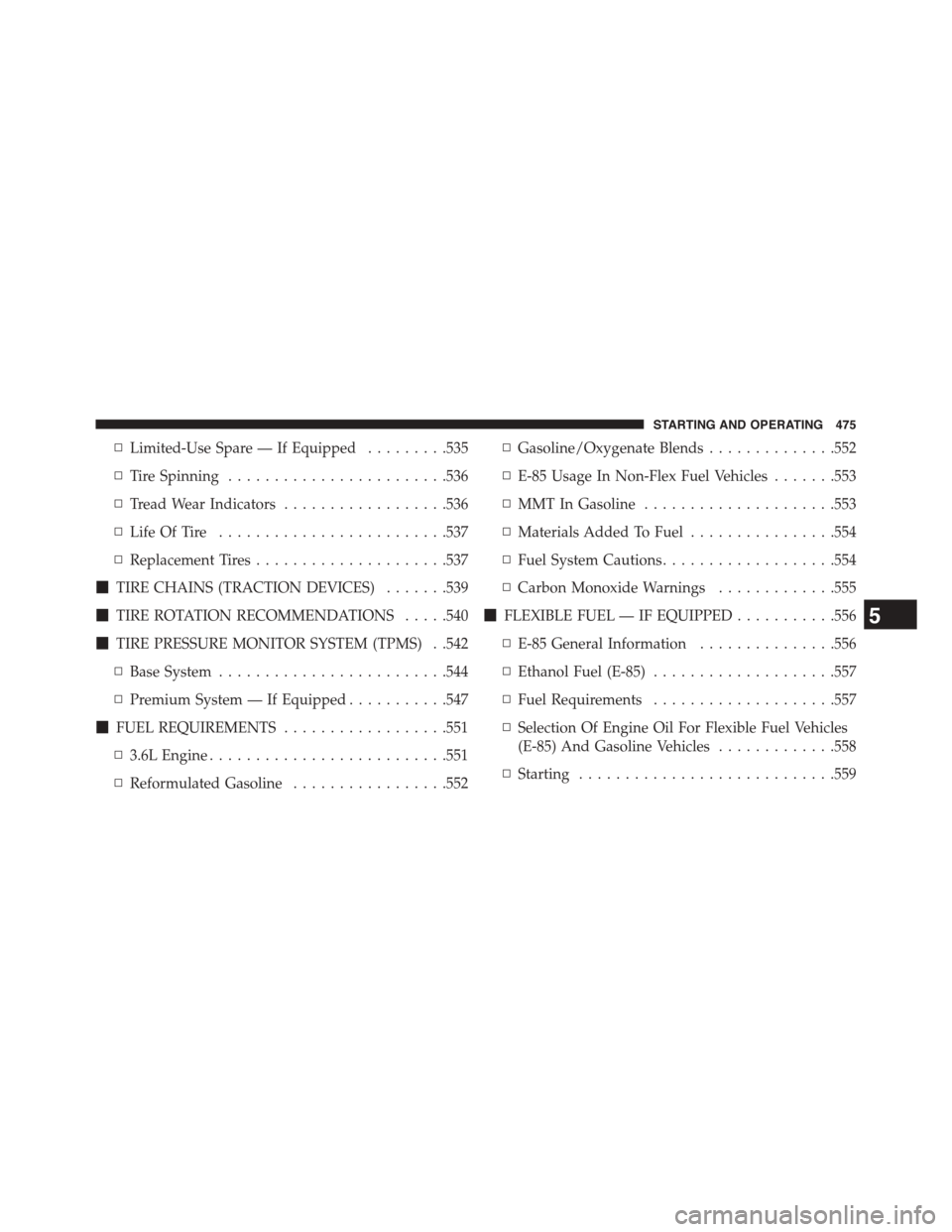
▫Limited-Use Spare — If Equipped.........535
▫Tire Spinning........................536
▫Tread Wear Indicators..................536
▫Life Of Tire.........................537
▫Replacement Tires.....................537
!TIRE CHAINS (TRACTION DEVICES).......539
!TIRE ROTATION RECOMMENDATIONS.....540
!TIRE PRESSURE MONITOR SYSTEM (TPMS) . .542
▫Base System.........................544
▫Premium System — If Equipped...........547
!FUEL REQUIREMENTS..................551
▫3.6L Engine..........................551
▫Reformulated Gasoline.................552
▫Gasoline/Oxygenate Blends..............552
▫E-85 Usage In Non-Flex Fuel Vehicles.......553
▫MMT In Gasoline.....................553
▫Materials Added To Fuel................554
▫Fuel System Cautions...................554
▫Carbon Monoxide Warnings.............555
!FLEXIBLE FUEL — IF EQUIPPED...........556
▫E-85 General Information...............556
▫Ethanol Fuel (E-85)....................557
▫Fuel Requirements....................557
▫Selection Of Engine Oil For Flexible Fuel Vehicles
(E-85) And Gasoline Vehicles.............558
▫Starting............................559
5
STARTING AND OPERATING 475
Page 478 of 726
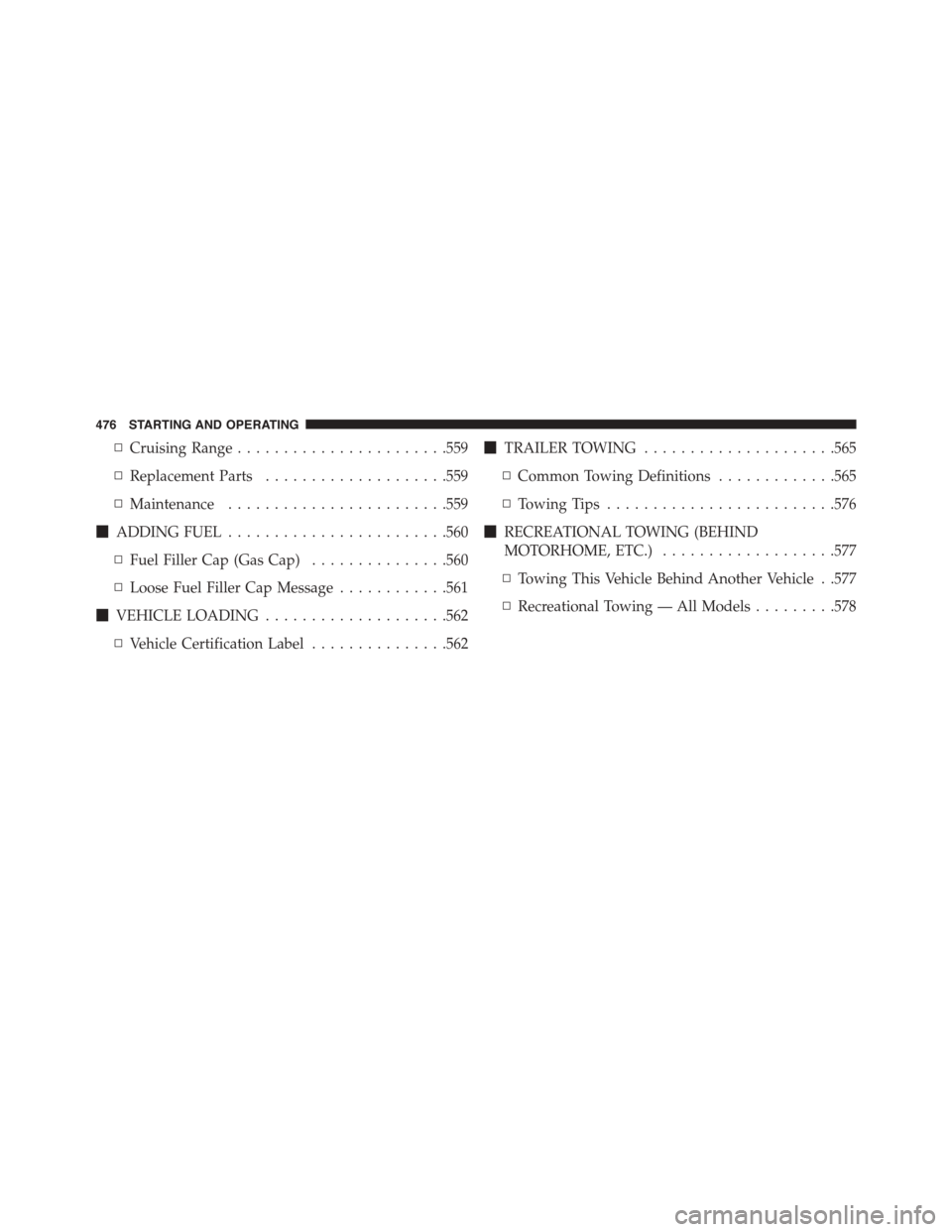
▫Cruising Range.......................559
▫Replacement Parts....................559
▫Maintenance........................559
!ADDING FUEL........................560
▫Fuel Filler Cap (Gas Cap)...............560
▫Loose Fuel Filler Cap Message............561
!VEHICLE LOADING....................562
▫Vehicle Certification Label...............562
!TRAILER TOWING.....................565
▫Common Towing Definitions.............565
▫Towing Tips.........................576
!RECREATIONAL TOWING (BEHIND
MOTORHOME, ETC.)...................577
▫Towing This Vehicle Behind Another Vehicle . .577
▫Recreational Towing — All Models.........578
476 STARTING AND OPERATING
Page 479 of 726
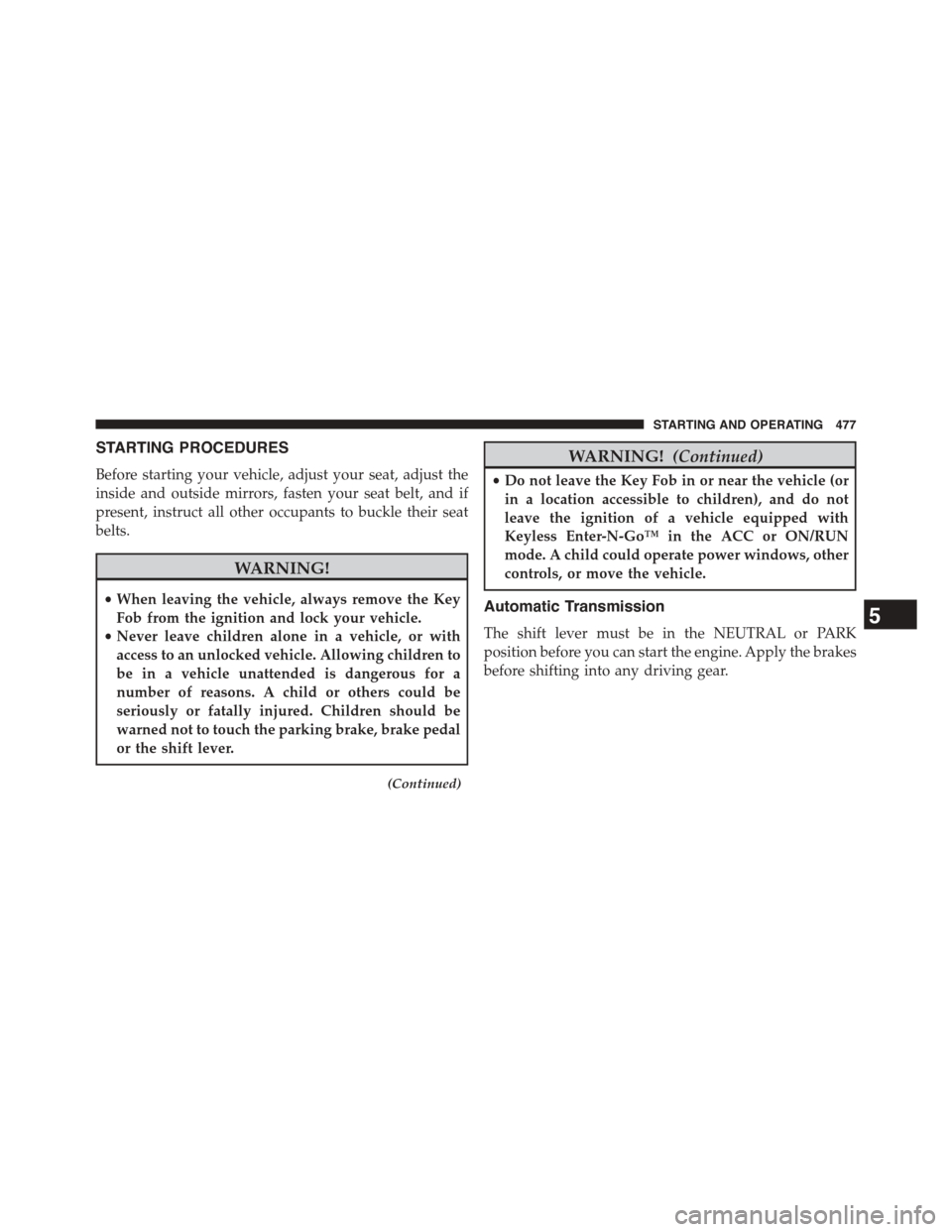
STARTING PROCEDURES
Before starting your vehicle, adjust your seat, adjust the
inside and outside mirrors, fasten your seat belt, and if
present, instruct all other occupants to buckle their seat
belts.
WARNING!
•When leaving the vehicle, always remove the Key
Fob from the ignition and lock your vehicle.
•Never leave children alone in a vehicle, or with
access to an unlocked vehicle. Allowing children to
be in a vehicle unattended is dangerous for a
number of reasons. A child or others could be
seriously or fatally injured. Children should be
warned not to touch the parking brake, brake pedal
or the shift lever.
(Continued)
WARNING!(Continued)
•Do not leave the Key Fob in or near the vehicle (or
in a location accessible to children), and do not
leave the ignition of a vehicle equipped with
Keyless Enter-N-Go™ in the ACC or ON/RUN
mode. A child could operate power windows, other
controls, or move the vehicle.
Automatic Transmission
The shift lever must be in the NEUTRAL or PARK
position before you can start the engine. Apply the brakes
before shifting into any driving gear.
5
STARTING AND OPERATING 477
Page 480 of 726
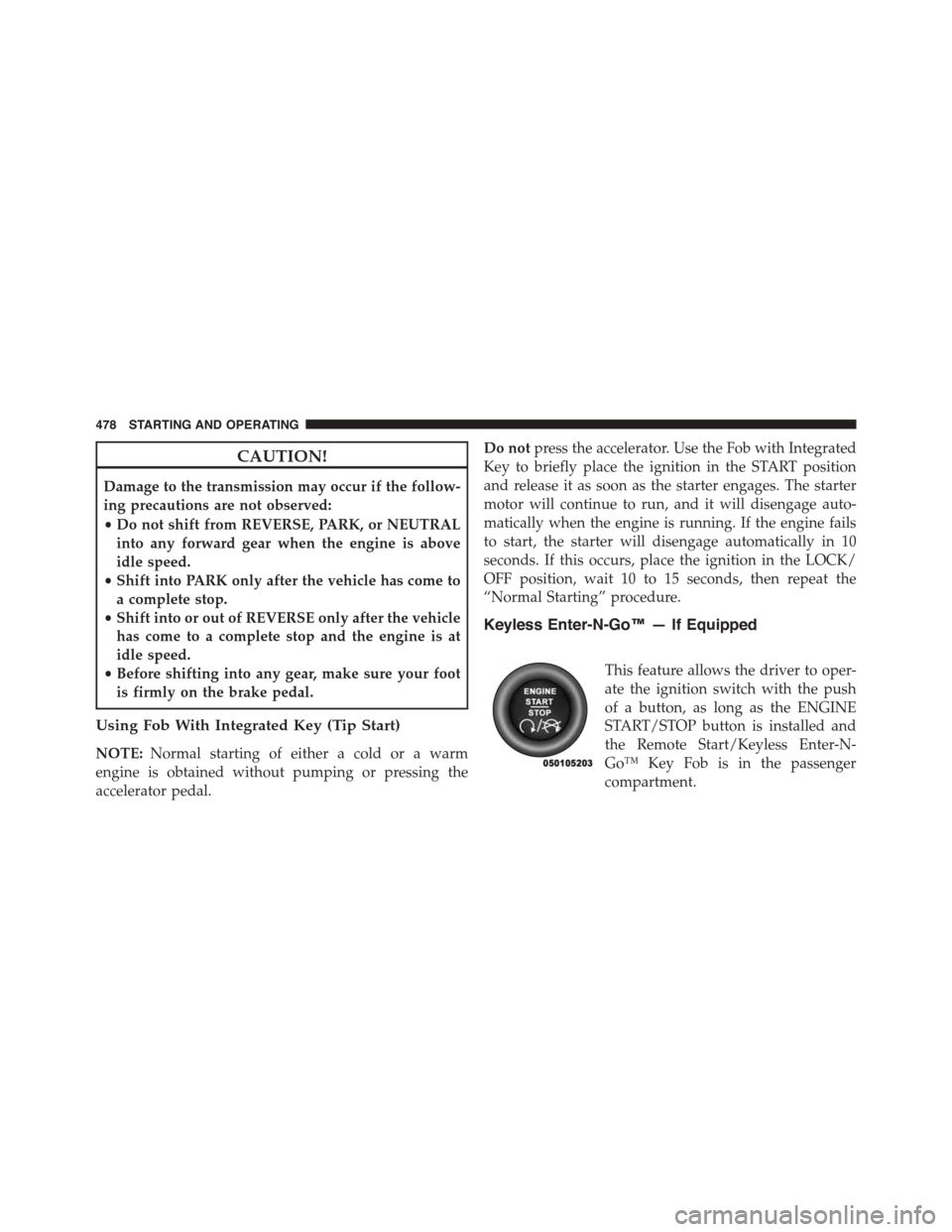
CAUTION!
Damage to the transmission may occur if the follow-
ing precautions are not observed:
•Do not shift from REVERSE, PARK, or NEUTRAL
into any forward gear when the engine is above
idle speed.
•Shift into PARK only after the vehicle has come to
a complete stop.
•Shift into or out of REVERSE only after the vehicle
has come to a complete stop and the engine is at
idle speed.
•Before shifting into any gear, make sure your foot
is firmly on the brake pedal.
Using Fob With Integrated Key (Tip Start)
NOTE:Normal starting of either a cold or a warm
engine is obtained without pumping or pressing the
accelerator pedal.
Do notpress the accelerator. Use the Fob with Integrated
Key to briefly place the ignition in the START position
and release it as soon as the starter engages. The starter
motor will continue to run, and it will disengage auto-
matically when the engine is running. If the engine fails
to start, the starter will disengage automatically in 10
seconds. If this occurs, place the ignition in the LOCK/
OFF position, wait 10 to 15 seconds, then repeat the
“Normal Starting” procedure.
Keyless Enter-N-Go™ — If Equipped
This feature allows the driver to oper-
ate the ignition switch with the push
of a button, as long as the ENGINE
START/STOP button is installed and
the Remote Start/Keyless Enter-N-
Go™ Key Fob is in the passenger
compartment.
478 STARTING AND OPERATING